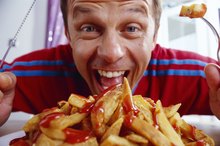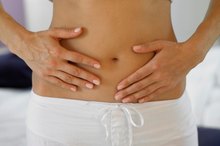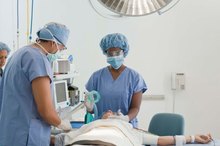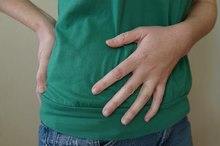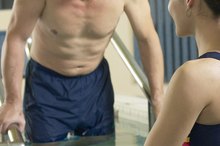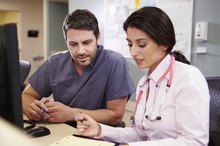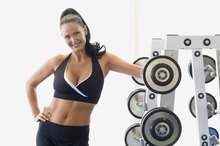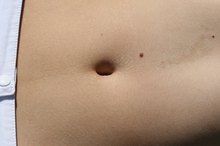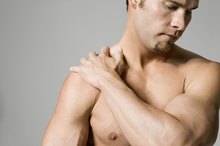Can You Exercise if You Have Gallstones?
Gallstones affect 10 to 15 percent of Americans, and about 800,000 people a year have operations to remove their gallbladder because of gallstones, notes Gallstones.com 1. Gallstones are small stone-like substances made from bile pigment or cholesterol that has developed within the gallbladder 1. Gallstones may be as small as a grain of sand or as large as a golf ball 1. In general, exercise is beneficial for gallstones, though there are circumstances when you should avoid exercise 1.
Gallbladder Function
The gallbladder stores bile produced by the liver and then releases the liquid bile into the small intestine after you’ve eaten to assist with digestion. The bile has bile salts that break down fats. When you eat fatty food, you place a greater burden on your gallbladder.
Risk Factors
Pain in the Upper Right Back After Eating
Learn More
Obese individuals are at a greater risk for developing gallstones 1. You can determine if you are obese using the calculator at National Heart Lung and Blood Institute (see Resources). People who lose weight quickly, undergo periods of prolonged fasting or who have a history of yo-yo dieting are also at greater risk, as are people with diabetes; those who take cholesterol-lowering drugs; those over the age of 60; and American Indians or Mexican Americans, according to the Weight–Control Information Network.
Symptoms
Many people have gallstones that are asymptomatic, and may go their entire life without ever having problems 1. Acute symptoms occur when a stone blocks the bile duct that leads out of the gallbladder, past the pancreas to the small intestine. Symptoms can include steadily increasing pain in the upper right abdomen that lasts from 30 minutes to days, pain under the right shoulder or back pain between the shoulder blades. Consult with a physician immediately if you have acute pain that persists longer than five hours and is accompanied by fever, nausea, vomiting, or a yellowish tint in the skin or in the whites of the eyes.
- Many people have gallstones that are asymptomatic, and may go their entire life without ever having problems 1.
Exercise and Risk of Gallstones
Side Effects of Gallstones
Learn More
If you don’t have gallstones, moderately intense exercise can lower your risk of developing them, and if you do have them, it can lower your risk of developing symptomatic gallstones 1. Research reported at “European Journal of Gastroenterology & Hepatology” found that those who engaged in a high level of physical activity had a 70 percent decreased risk of developing symptomatic gallstones after five years 12. Those who exercise less intensely also have a decreased risk of acute symptoms of gallstones 1.
Exercise With Gallstones
If you have silent gallstones, stones that are not symptomatic, continue with your regular exercise routine 1. Exercise helps you lose weight, which reduces your risk of developing symptomatic gallstones 1. A steady pattern of exercise, along with a moderate-calorie, low-fat diet may lower the risk of symptomatic gallstones above and beyond the effects of weight loss alone 1.
Acute Symptomatic Gallstones
If you have acute symptoms of gallstones, such as pain in the abdomen, it is unlikely you will feel like exercising 1. Even if you are a die-hard exercise buff, you are best off forgoing your workout until your gallstone symptoms subside. Listen to your body. This is a time it is best to not work through your pain. If symptoms persist for more than five hours, call your doctor. If the symptoms pass and you feel fine, then you may still want to consult with your doctor, but you will likely get the go ahead to continue with your exercise program.
- If you have acute symptoms of gallstones, such as pain in the abdomen, it is unlikely you will feel like exercising 1.
- If the symptoms pass and you feel fine, then you may still want to consult with your doctor, but you will likely get the go ahead to continue with your exercise program.
Related Articles
References
- Gallstones.com: About Gallstones
- "European Journal of Gastroenterology & Hepatology": Physical Activity Reduces the Risk of Symptomatic Gallstones: A Prospective Cohort Study
- National Institute of Diabetes and Digestive and Kidney Diseases. Symptoms & Causes of Gallstones. Updated November 2017.
- Stinton LM, Shaffer EA. Epidemiology of gallbladder disease: cholelithiasis and cancer. Gut Liver. 2012;6(2):172-87. doi:10.5009/gnl.2012.6.2.172
- Johns Hopkins Medicine. Gallstones.
- National Institute of Diabetes and Digestive and Kidney Diseases. Dieting & Gallstones. Updated November 2017.
- Johansson K, Sundström J, Marcus C, Hemmingsson E, Neovius M. Risk of symptomatic gallstones and cholecystectomy after a very-low-calorie diet or low-calorie diet in a commercial weight loss program: 1-year matched cohort study. Int J Obes (Lond). 2014;38(2):279-84. doi:10.1038/ijo.2013.83
- Johns Hopkins Medicine. Gallstones.
- Mayo Clinic Staff. Gallstones. Mayo Clinic. Updated November 17, 2017.
- National Institute of Diabetes and Digestive and Kidney Diseases. Dieting and Gallstones. National Institutes of Health. U.S. Department of Health and Human Services. Updated November 2017.
- National Institute of Diabetes and Digestive and Kidney Diseases. Symptoms and Causes of Gallstones. National Institutes of Health. U.S. Department of Health and Human Services. Updated November 2017.
- Portincasa P, Di Ciaula A, Grattagliano I. Preventing a Mass Disease: The Case of Gallstones Disease: Role and Competence for Family Physicians. Korean Journal of Family Medicine. 2016;37(4):205-213. doi:10.4082/kjfm.2016.37.4.205.
Resources
Writer Bio
Jon Williams is a clinical psychologist and freelance writer. He has performed, presented and published research on a variety of psychological and physical health issues.
